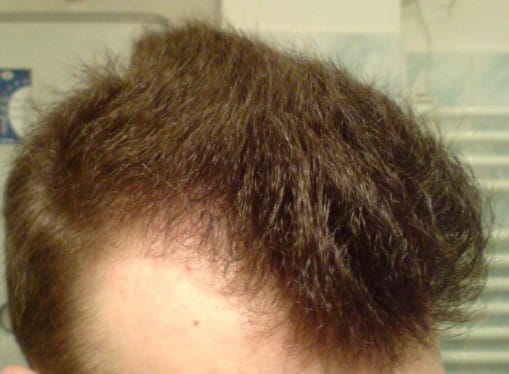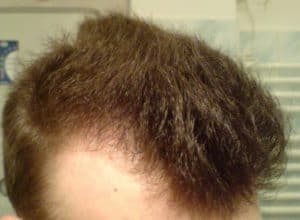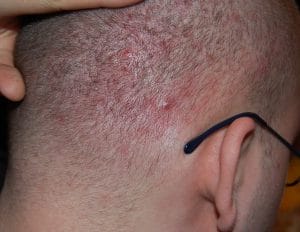
Skin diseases – of which hair loss is a symptom.
How many of us stand in front of the mirror in the morning and marvel at the fact that our hair has thinned out a bit too much and an ever-growing bald spot is showing through? The hairline bends, recedes along the forehead and an unsightly bald spot can appear on top of the head as well. On the surface, this may seem like nothing to worry about and most men think nothing of worrying about this natural process that inevitably occurs with age. However, it is often encountered even before the age of 30 and even earlier, and then it can be a sign of developing diseases in the body. There are many of them, they do not only concern the scalp, they may also be systemic or autoimmune but they all have one thing in common, their most important and characteristic symptom is accelerated hair loss, in short, alopecia.
Contents
The health of the whole organism influences the health of our hair

Unless hairloss is caused by neglecting our daily hair care, hair loss is most often directly related to the state of our health. A malfunction of the whole or part of the body, a weakened immune system or even a lack of vitamins, minerals and other essential nutrients quickly takes their toll on the condition of hair. It becomes brittle and fragile , loses its elasticity and this is the first step to accelerated balding, which will be difficult to control. Unfortunately, it often turns out that we suffer from various skin diseases, whose treatment is difficult and prolonged, and any negligence can end up with serious complications. Equally important is the lifestyle we lead and, above all, our diet, because what we eat has a direct impact not only on the appearance of hair, but also on the ailments that can cause it to fall out.
The most common skin diseases that are symptomatic of accelerated and excessive hair loss

There’s no denying that the number of skin conditions associated with hair loss is enormous, and it would take hours to review them all. The causes that cause them are also numerous, although some recur simultaneously with different, seemingly disparate conditions. The most important issue, however, is their correct diagnosis, which we absolutely should not deal with ourselves, which can sometimes have unpleasant consequences, the deterioration of our health due to improper treatment. If we see that with the hair is happening something disturbing, and their amount on the brush or comb exceeds the norm of 100 – 150 hairs falling out naturally per day, it is time to start acting. In many cases, there is no need to immediately run to a doctor, such as a dermatologist, although it certainly can not hurt, just start by consulting a specialist who can diagnose the condition. trichologistIn many cases, you do not have to run straight to a doctor – for example to a dermatologist – although it certainly does not hurt to do so. He has the appropriate equipment for this purpose, which allows a thorough inspection of the skin and individual hair for possible ailments that cause accelerated balding. If our problem requires the intervention of a doctor, he will certainly refer us to him, and the most common skin diseases manifested by baldness are:
Chronic ringworm of the scalp
This is a very common ailment caused by fungi growing on the skin that usually belong to two species, Microsporum canis and Trichophyton tonsurans. This disease is certainly not the most pleasant in terms of symptoms, and its treatment is long-lasting and requires the use of specialized medications. It can be divided into several varieties depending on its location:
- tinea capitis, when fungi settle on the external surface of the hair;
- wax mycosis, with the fungi located inside the hair structure;
- tinea cutis, which can be divided into superficial and deep tinea, here also fungi are located inside the hair and it manifests itself by hair peeling to the point of its total loss and the possibility of skin scarring as a result of inflammation accompanying the disease.
Symptoms of dermatomycosis cannot be overlooked, most of them, depending on the type of mycosis, may cause additional discomfort, and the most characteristic are:
- redness and irritation, often very painful, whose cause is a developing strong inflammation of the skin;
- exfoliation of the skin causing difficult to control dandruff;
- cracks causing wounds;
- strong thinning of the hair, its excessive brittleness and falling out in large amounts, especially directly in the affected areas, and in the case of ringworm it may end up with complete baldness and leave permanent scars;
- characteristic appearance of hair that looks like it was crookedly cut at different lengths and covered with fungal spores in the form of small white dots.
Seborrhoeic dermatitis
Another serious disease that can become the cause of rapid thinning of our hairstyle, usually occurring in people just entering adulthood, or puberty. It develops as a result of disorders of the skin sebaceous glands, which produce excessive amounts of sebum, at the same time of incorrect chemical composition, and such disorders may even result from our negligence in hygiene. Other factors conducive to its development are stress, use of improper cosmetics, weakened immunity of the body, hormonal disorders. Regardless of the causes seborrhoeic dermatitis manifests itself
- significant thinning of hair, often irreversible;
- skin changes in the form of red, inflamed spots or equally troublesome acne;
- severe flaking of the epidermis;
- oily skin with a characteristic yellow colour caused by excess sebum secretion;
- burning, itching and even pain in the affected areas.
Seborrheic dermatitis is also the cause of another, equally dangerous disease, seborrheic alopecia also caused by excessive sebum secretion and seborrheic dandruff. The consequence of the latter, if not treated properly, can also be a complete loss of hair.
Atopic Dermatitis
Called AD for short, another cause of hair loss that we must include in our list. Unfortunately, this is a condition that cannot be completely cured, and the treatment itself consists in alleviating the symptoms that appear, such as:
- dry, rough to the touch skin with characteristic discolourations;
- itching, forcing constant scratching, which can lead to further complications, including serious infections.
Among the most important causes of the development of atopic dermatitis is the misrecognition of allergens by our immune system and the extremely severe reactions to them. Atopic dermatitis also attacks the scalp and negatively influences hair follicles, weakening them to a degree that causes gradual hair loss. We can also cause this ourselves through intense scratching of the itching areas, leading to further fungal or bacterial infections.
Purulent chronic folliculitis
Developing as a result of bacterial infection of the skin, most often dangerous Staphylococcus aureus or streptococcus, can also be caused by diseases such as diabetes mellitus or disorders of the immune system. Hair follicles are necessary for proper hair growth, their damage also causes the hormone DHT, and inflammation manifests itself:
- skin lesions, pustules filled with pus or serous fluid, which may even develop into larger ulcers or boils with a large diameter;
- itching and pain in these areas;
- a developing inflammation, often accompanied by fever;
- hair loss.
All this leads to the gradual death of follicles, accelerated by scratching the affected areas or squeezing the resulting pimples, which must not be done, and the result is permanent scarring.
Psoriasis
One of the worst, chronic, but fortunately not contagious skin diseases, whose causes have not been clearly defined until now. Influence on its development have among others genetic factors, may also be caused by recurrent bacterial or viral infections. Our general state of health is of great importance in its prevention, and the factor that opens the way for psoriasis is, among others, weakened immunity, which may result even from improper diet. Therefore, it is worth keeping a proper diet, thanks to which we are not threatened by overweight and obesity, limit stimulants, especially alcohol, and avoid situations that may aggravate stress symptoms. Symptoms of psoriasis, depending on their severity, may sometimes even arouse fear, especially when we observe an increasing number of skin lesions, papules of varying color from red to dark brown. They may also be located on the scalp and therefore become the cause of hair weakening and loss, which occurs primarily as a result of inflammation of hair follicles. The process of baldness is usually reversible, however, there are situations in which hair does not grow back.
Hashimoto disease, incurable thyroiditis
A serious autoimmune disease, also with skin symptoms, affecting mostly women, which is a chronic and unfortunately incurable form of lymphocytic thyroiditis. It is caused by various factors, but most often specialists point to genetic conditions, and the exact causes have still not been precisely determined. It is also associated with other thyroid diseases, either hypothyroidism or hyperthyroidism. Hashimoto may be asymptomatic and go undetected for a long time, but it usually presents with symptoms that allow a quick diagnosis, such as
- a constant feeling of sleepiness and fatigue, even without previous exertion;
- swelling leading even to a visible change in facial features;
- uncontrolled weight gain;
- elevated blood cholesterol levels;
- anaemia;
- memory and concentration problems;
- mental problems, including insomnia and mood swings, from euphoric states to emerging symptoms of depression;
- severe pains in the joints, their reduced mobility;
- problems with the heart and circulatory system, bradycardia or hypertension;
- excessive dryness of the skin causing painful irritation and peeling of the epidermis, which also has an impact on increased fragility, brittleness and finally hair loss.
Cancer diseases and the methods used for their treatment
In many cases they are a threat not only to our health but also life, and one of their common symptoms is hair loss. It happens not only because of the course of the disease, but also because of the applied treatment methods. The most important cause of baldness are skin cancers, irreversibly destroying hair follicles and hair bulbs, and hair loss is usually irreversible. Similar effects are also given by cancer types attacking other parts of the body and giving metastases practically to the whole body, including the scalp. The same havoc in hair is caused by two main methods of cancer treatment, namely chemotherapy and radiotherapy. The first one consists in giving the patient drugs that stop the division of uncontrollably multiplying cancer cells, and the second one consists in irradiating the lesions with ionizing radiation, which unfortunately damages healthy cells as well. This ends with loss of large amounts of hair, but in many cases you can count on their regrowth.
Anti-alopecia tablets – make up for all nutrient deficiencies
The above-mentioned diseases may affect each of us, but to a large extent, we can effectively prevent them by providing our body with all the necessary nutrients. For this purpose, carefully selected preparations, dietary supplements are used, and the most effective, proven and tested ones can be found at the link below and are definitely worth getting acquainted with.



